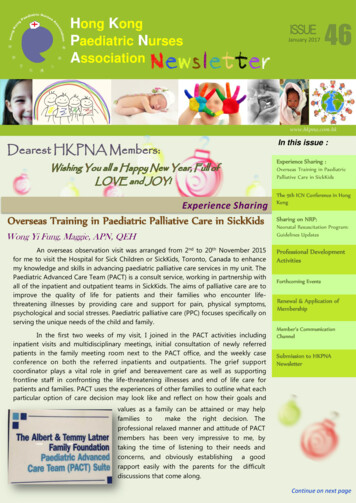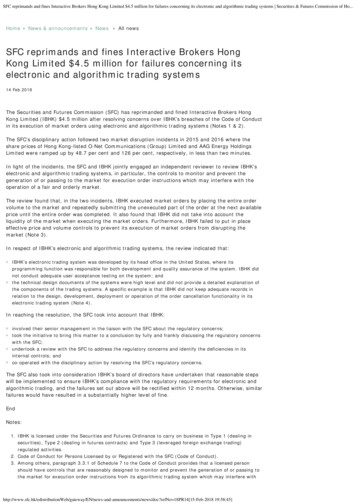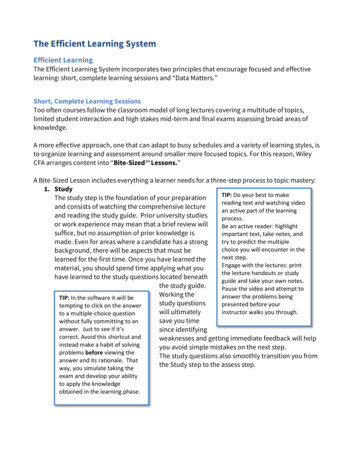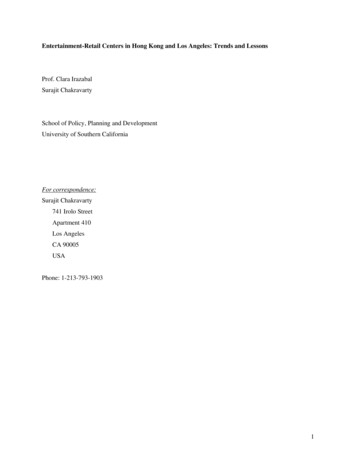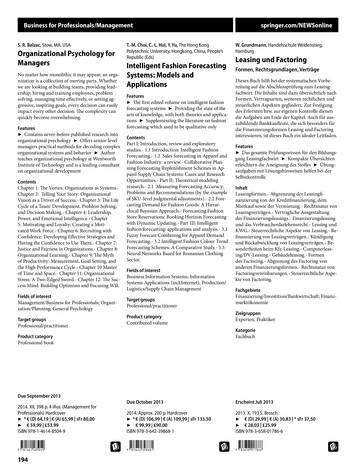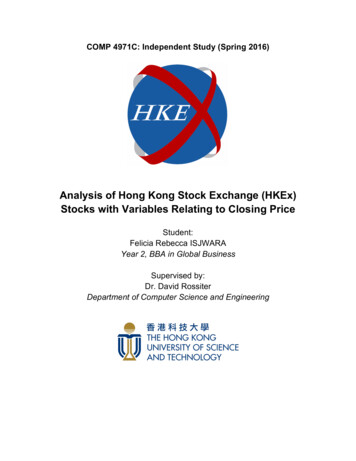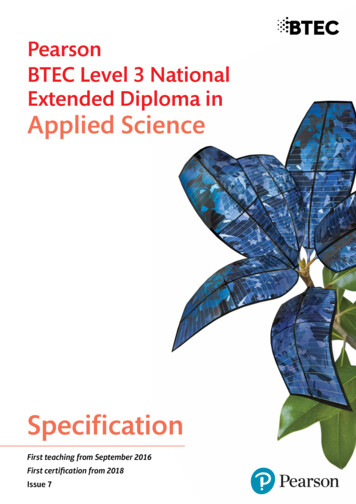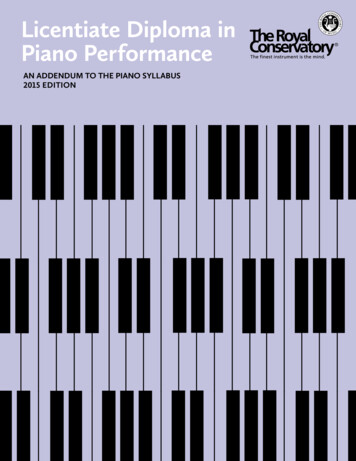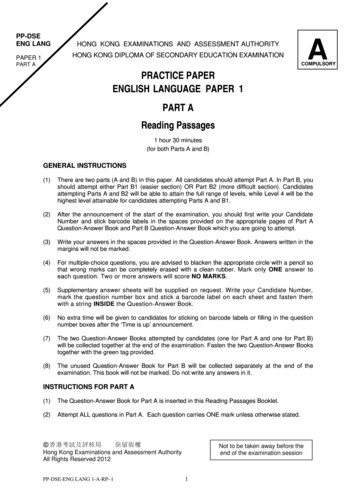
Transcription
PP-DSEENG LANGHONG KONG EXAMINATIONS AND ASSESSMENT AUTHORITYHONG KONG DIPLOMA OF SECONDARY EDUCATION EXAMINATIONPAPER 1ACOMPULSORYPULSORYPART APRACTICE PAPERENGLISH LANGUAGE PAPER 1PART AReading Passages1 hour 30 minutes(for both Parts A and B)GENERAL INSTRUCTIONS(1)There are two parts (A and B) in this paper. All candidates should attempt Part A. In Part B, youshould attempt either Part B1 (easier section) OR Part B2 (more difficult section). Candidatesattempting Parts A and B2 will be able to attain the full range of levels, while Level 4 will be thehighest level attainable for candidates attempting Parts A and B1.(2)After the announcement of the start of the examination, you should first write your CandidateNumber and stick barcode labels in the spaces provided on the appropriate pages of Part AQuestion-Answer Book and Part B Question-Answer Book which you are going to attempt.(3)Write your answers in the spaces provided in the Question-Answer Book. Answers written in themargins will not be marked.(4)For multiple-choice questions, you are advised to blacken the appropriate circle with a pencil sothat wrong marks can be completely erased with a clean rubber. Mark only ONE answer toeach question. Two or more answers will score NO MARKS.(5)Supplementary answer sheets will be supplied on request. Write your Candidate Number,mark the question number box and stick a barcode label on each sheet and fasten themwith a string INSIDE the Question-Answer Book.(6)No extra time will be given to candidates for sticking on barcode labels or filling in the questionnumber boxes after the ‘Time is up’ announcement.(7)The two Question-Answer Books attempted by candidates (one for Part A and one for Part B)will be collected together at the end of the examination. Fasten the two Question-Answer Bookstogether with the green tag provided.(8)The unused Question-Answer Book for Part B will be collected separately at the end of theexamination. This book will not be marked. Do not write any answers in it.INSTRUCTIONS FOR PART A(1)The Question-Answer Book for Part A is inserted in this Reading Passages Booklet.(2)Attempt ALL questions in Part A. Each question carries ONE mark unless otherwise stated.保留版 權 香港 考試及 評核局Hong Kong Examinations and Assessment AuthorityAll Rights Reserved 2012PP-DSE-ENG LANG 1-A-RP–1Not to be taken away before theend of the examination session1
PART ARead Text 1 and answer questions 1-23 on pages 1-4 of the Question-Answer Book for Part A.Text 1An OceanApartDoes keeping large animals in aquariumsand zoos foster social benefits like educationand conservation, or is it unethical, sendingthe wrong message to young minds? Readwhat two people have to say about both sidesof the issue.Suzanne Gendron is Executive Director of Zoological Operations and Education at Ocean Park,Hong Kong.1 [1] Zoos, aquariums and marine parks havebeen widely and rightly recognised by thepublic and by governments for their longstanding contributions to marine education and5 protection of ocean wildlife and habitats.Worldwide, good zoos and aquariums host over600 million visitors each year, and in HongKong alone, close to 5 million people visitOcean Park annually. For all these people, zoos10 and aquariums are a resource for wildlifeeducation, motivators for environmentalstewardship and a place for family recreation.35 [4] A recent study by Dr Lance Miller, abehavioural biologist with the San Diego Zoo,demonstrated an increase in conservationrelated knowledge, attitudes and behaviouralintentions immediately after guests viewed a40 dolphin show. Three months later, in the nextround of interviews, these guests reported thatthey were engaging in more conservationrelated behaviour since their dolphin showexperience. They also retained what they had45 learned. These findings echo those of a studyconducted at Ocean Park about our dolphininteractive programme where, three monthsafter their participation, guests’ positiveattitudes towards the environment were still50 stronger than before the programme.[2] At Ocean Park Academy, over 35,000schoolchildren participate each year in our15 courses. They include children with specialfinancial needs and children from schools inremote areas. Guests can also participate in ouranimal encounter programme, which gives thema chance to see some of Asia’s rarest animals.20 Even our restaurants display information panelswhich advocate wise seafood choices in supportof sustainable agricultural and fisheriespractices.[5] Most Hong Kong families live in urbansettings, increasingly withdrawn into anelectronic world of computer downloads,satellite media and video games. Children are55 losing touch with nature and the animal world.In a time of environmental challenges, zoos andaquariums are vital links to nature and wildlife.They connect real-life people and real-lifeanimals, and foster the understanding that it is60 more important, now than ever before, toconserve our natural environment.[3] Polls and studies confirm that seeing living,25 breathing animals in zoological facilitiesinspires children and adults to care aboutprotecting marine mammals and their decliningocean environments. A poll taken in 2005found that the public was nearly unanimous in30 its acclaim for the educational impact of marinelife parks, zoos and aquariums.Manyrespondents agreed that the experience of seeinganimals in zoos could not be replicated by filmor television.PP-DSE-ENG LANG 1-A-RP–2[6] Saving the planet’s biodiversity isincreasingly more challenging. It is throughgood zoos and aquariums that children, families65 andcommunitiescanmeet nature’sambassadors. Through these connections, theywill help save the wild places and wild animalsso that future generations will appreciate thethrill of nature.2
Peter Singer is Professor of Bioethics at Princeton University and Laureate Professor at the Universityof Melbourne.70 [7] In February 2010, at the Sea Worldamusement park in Florida, USA, a whalegrabbed a trainer, Dawn Brancheau, pulled herunderwater and thrashed about with her. By thetime rescuers arrived, Brancheau was dead. The75 death of the trainer is a tragedy, and one canonly have sympathy for her family. But theincident raises broader questions: was the attackdeliberate? Did the whale, nicknamed Tilly, actout of stress at being held captive in a sterile80 concrete tank? Was he tired of being forced toperform to amuse the crowds? Is it right to keepsuch large animals in close confinement?[8] Tilly had been involved in two previoushuman deaths. In one episode, a trainer fell85 into the pool and Tilly and two other whalesdrowned him. In another, a man who appearsto have entered the aquarium at night, whenSea World was closed, was found dead in thepool with Tilly. An autopsy showed he had a90 bite mark. One of Tilly’s offspring, sold to anamusement park in Europe, has also killed atrainer, as have whales in other parks.[9] Richard Ellis, a marine conservationist atthe American Museum of Natural History,95 believes orcas (a particular species of whales)are smart and would not do such a thing purelyon impulse. ‘This was premeditated,’ he said.We will never know exactly what was going onin Tilly’s mind, but we do know that he has100 been in captivity since he was about two yearsold. Orcas are social mammals, and he wouldhave been living with his mother and otherrelatives in a group. The sudden separationwas probably traumatic for Tilly.[11] But if we are pointing the finger at Sea115 World, we should also look more broadly at theway we confine performing animals. In mostzoos, visitors see bored animals pacing back andforth in cages, with nothing to do but wait forthe next meal.120 [12] Circuses are even worse places for animals.Their living conditions are deplorable, especiallyin travelling circuses where cages have to besmall so that they can go on the road. Traininganimals to perform tricks often involves125 starvationandcruelty.Undercoverinvestigations have repeatedly shown animalsbeing beaten and given electric shocks.[13] Attempts to defend amusement parks andcircuses on the grounds that they ‘educate’130 people about animals should not be takenseriously. Such enterprises are part of theentertainment industry. The most importantlesson they teach impressionable young minds isthat it is acceptable to keep animals in captivity135 for human amusement. That is the opposite ofthe ethical attitude that we should be seeking toteach children.[14] There is no excuse for keeping wild animalsin amusement parks or circuses. Until our140 governments take action, we should avoidsupporting places where captive wild animalsperform for our amusement. If the public willnot pay to see them, the businesses that profitfrom keeping animals captive will not be able to145 continue.105 [10] Moreover, the degree of confinement inaquariums is extreme, for no tank, no matterhow large, can come close to meeting the needsof animals who spend their lives in socialgroups swimming long distances in the ocean.110 Joyce Tischler, of the Animal Legal DefenceFund, described keeping a six-tonne whale inSea World’s tanks as akin to keeping a humanin a bathtub for his entire life.END OF READING PASSAGESSources of materials used in this paper will be acknowledged in the Hong Kong Diploma of Secondary EducationExamination Practice Papers published by the Hong Kong Examinations and Assessment Authority at a later stage.PP-DSE-ENG LANG 1-A-RP–33
Please stick the barcode label here.Candidate NumberHKDSE PRACTICE PAPERENGLISH LANGUAGE PAPER 1PART AQUESTION-ANSWER BOOKACOMPULSORYWrite your Candidate Number and stick a barcode label in the space provided on this page.Read Text 1 and answer questions 1-23. (40 marks)Answers written in the margins will not be marked.2.What is the main idea of paragraph 1? Zoos, aquariums and marine parks A. are funded by governments.B. are well supported by the general public.C. are attracting increasing numbers of visitors each year.D. are centres of education, conservation and entertainment.ABCDAccording to line 9, who are ‘these people’?3.4.Which meaning of ‘resource’ is closest to the meaning used in line 10?A.a country’s source of wealth or revenuee.g. Minerals are an important resource in Australia.B.a source of information or expertisee.g. Books are an important resource for study.C.an ability to meet and handle a situatione.g. Employers will find Mary’s initiative an attractive resource.D.a supply of materials that can be drawn on when needede.g. Low income families have fewer financial resources.ABCDFrom the information given in paragraph 2, name THREE ways that Ocean Park promotes wildlife education.(3 marks)a)b)c)5.‘Wise seafood choices’ (line 21) refers to eating fish that is .A.B.C.D.not endangered.clean and properly cooked.the special catch of the day.healthy and nutritious.ABCAnswers written in the margins will not be marked.*A020E01A*PP-DSE-ENG LANG 1-A-QAB–11DAnswers written in the margins will not be marked.1.
6.From the information given in paragraphs 3 and 4, decide if the following statements are true (T), false (F) ornot given (NG). (3 marks)a) The ocean environment is in decline due to overfishing.b) People do not remember much of what they have learned after watching a dolphin show.c) Ocean Park’s own research results were similar to those of Dr Lance Miller.7.Which of the following figures was the more likely result of the poll taken in 2005 (line 28)?A. 10%B. 49%C. 95%D. 100%8.ABCDDo you agree with the statement that ‘seeing animals in zoos could not be replicated by film or television’(lines 32-34)? Why or why not?9.In Dr Lance Miller’s study, how many times were the dolphin show guests interviewed?A. oneB. twoABC. threeD. fourCD10. What does ‘their’ in line 48 refer to?11. a) According to paragraph 5, why are children losing touch with nature? Give TWO different reasons. (2 marks)i)ii)b) Explain how these reasons might cause children to lose touch with nature.12. ‘Nature’s ambassadors’ (lines 65-66) refers to 13. According to paragraph 7, why was Sea World in the news?Answers written in the margins will not be marked.PP-DSE-ENG LANG 1-A-QAB–22Answers written in the margins will not be marked.Answers written in the margins will not be marked.
14. In line 73, what does ‘thrashed about’ mean?A.B.C.D.to play withto fight withto swim very quicklyto move about violentlyABCDCD15. Find TWO phrases in paragraph 7 that mean the same as ‘being kept a prisoner’. (2 marks)a)Answers written in the margins will not be marked.16. What does the expression ‘pointing the finger at’ mean in line 114?A. to look at an issue closelyB. to put the blame on someoneC. to address someone rudelyD. to query someone or somethingAB17. How are circuses worse places for animals than zoos and aquariums? Name two different ways. (2 marks)a)b)18. What do paragraphs 10-14 tell us about the writer’s attitudes and opinions?1.2.3.4.5.A.B.C.D.He feels strongly about animals being kept in captivity.He is a defender of places like Sea World.He is critical of amusement parks and circuses.He is concerned about how we educate the future generation.He expects the government to solve the world’s problems.1, 2 and 51, 3 and 42, 3 and 42, 4 and 5ABCD19. What does ‘such enterprises’ (line 131) refer to?20. Why is the title ‘An Ocean Apart’ used?A.B.C.D.The text is about marine mammals.Aquariums are apart from the ocean.The two writers have very different opinions.The text contains information about local and overseasaquariums.ABCDAnswers written in the margins will not be marked.PP-DSE-ENG LANG 1-A-QAB–33Go on to the next pageAnswers written in the margins will not be marked.b)
21. Below is an article about the incident that happened at Sea World. Fill in the blanks using words that can befound in paragraphs 7-10. Use one word for each blank. One example has been done for you. (8 marks)questions are being asked whether anything could have been doneAfter the death of D
grabbed a trainer, Dawn Brancheau, pulled her underwater and thrashed about with her. By the time rescuers arrived, Brancheau was dead. The death of the trainer is a tragedy, and one can only have sympathy for her family. But the incident raises broader questions: was the attack deliberate? Did the whale, nicknamed Tilly, act out of stress at being held captive in a sterile concrete tank? Was .
